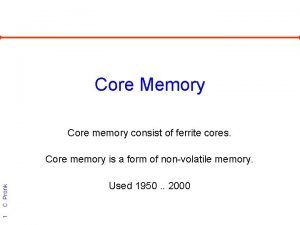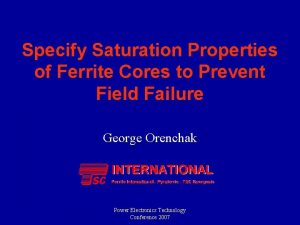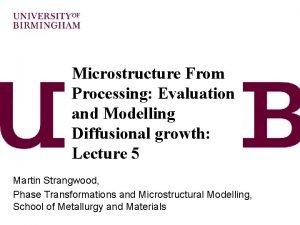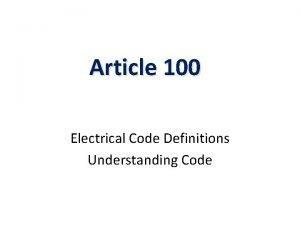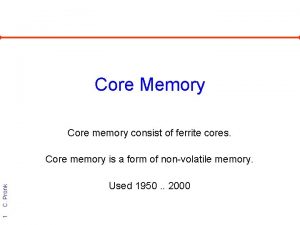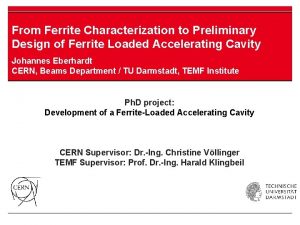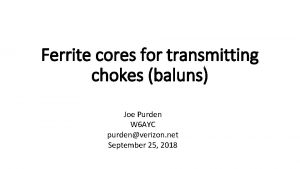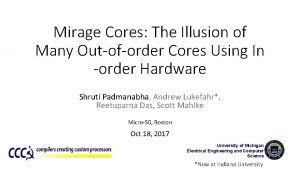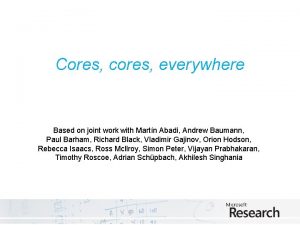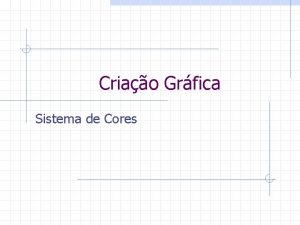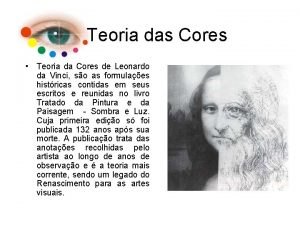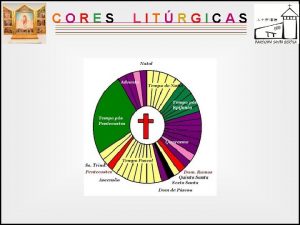Core Memory Core memory consist of ferrite cores













- Slides: 13

Core Memory Core memory consist of ferrite cores. 1 C. Pronk Core memory is a form of non-volatile memory. Used 1950. . 2000

2 C. Pronk Core Memory: Construction The "Donuts" are made of Ferrite, a material that can hold a magnetic field in either of two directions, thus representing "1" or "0". The wires through the cores allow the computer to set or read the magnetic direction. or

A Core Stack 3 C. Pronk A Core Stack containing 500 bytes

4 C. Pronk 65536 bits(!) of core memory

5 C. Pronk Bit by bit Each ring stores one bit (a 0 or 1). One bit in each plane could be accessed in one cycle, so each machine word in an array of words was spread over a stack of planes. Each plane would manipulate one bit of a word in parallel, allowing the full word to be read or written in one cycle.

6 C. Pronk Construction Core relies on the hysteresis of the magnetic material used to make the rings. Only a magnetic field over a certain intensity (generated by the wires through the core) can cause the core to change its magnetic polarity. To select a memory location, one of the X and one of the Y lines are driven with half the current required to cause this change. Only the combined magnetic field generated where the X and Y lines cross is sufficient to change the state, other cores will see only half the needed field, or none at all. By driving the current through the wires in a particular direction, the resulting induced field forces the selected core's magnetic field to point in one direction or the other (north or south).

7 C. Pronk Configuration

Destructive Read-out 8 C. Pronk A read operation on a core memory bit is always destructive, so the read operation must always be followed by a write operation. Cycle times for core memory were around 1 microsecond. This is comparable to processor cycle time in those days.

Non-volatile Core memory is non-volatile storage – it can retain its contents indefinitely without power. It is also relatively unaffected by EMP and radiation. 9 C. Pronk These were important advantages for some applications like military installations and vehicles like fighter aircraft, as well as spacecraft, and led to core being used for a number of years after availability of semiconductor MOS memory. For example, the Space Shuttle flight computers initially used core memory, which preserved the contents of memory.

10 C. Pronk On display:

The future(? ) M-RAM - 1 11 C. Pronk • Magnetoresistive Random Access Memory (MRAM) is a non-volatile computer memory (NVRAM) technology, which has been under development since the 1990 s. Continued increases in density of existing memory technologies, notably Flash RAM and DRAM kept MRAM in a niche role in the market, but its proponents believe that the advantages are so overwhelming that MRAM will eventually become dominant. Copied from wikipwedia under GNU Free Documentation License, Version 1. 2

The future(? ) M-RAM - 2 12 C. Pronk • Unlike conventional RAM chip technologies, in MRAM data is not stored as electric charge or current flows, but by magnetic storage elements. The elements are formed from two ferromagnetic plates, each of which can hold a magnetic field, separated by a thin insulating layer. One of the two plates is a permanent magnet set to a particular polarity, the other's field will change to match that of an external field. A memory device is built from a grid of such "cells". Copied from wikipwedia under GNU Free Documentation License, Version 1. 2

13 C. Pronk The future(? ) M-RAM - 3 Copied from wikipwedia under GNU Free Documentation License, Version 1. 2
 Ferrite core memory
Ferrite core memory Ferrite core properties
Ferrite core properties Widmanstatten ferrite
Widmanstatten ferrite Ferrite choke balun
Ferrite choke balun What does the federal bureaucracy consist of
What does the federal bureaucracy consist of What consists of the uk
What consists of the uk Raster scan display and vector scan display
Raster scan display and vector scan display Wiring components are considered accessible if
Wiring components are considered accessible if Carbohydrates consist of
Carbohydrates consist of Sample food chain
Sample food chain Primary villi consist of
Primary villi consist of Ipo programming
Ipo programming What do taoist believe
What do taoist believe Safety net drop tests must consist of a
Safety net drop tests must consist of a
